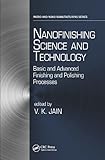Nanofinishing Science and Technology : Basic and Advanced Finishing and Polishing Processes.
By: Jaina, Vijayakumāra .
.
Material type:  BookSeries: Publisher: Portland : CRC Press, 2016Description: 1 online resource (676 pages).Content type: text Media type: computer Carrier type: online resourceISBN: 9781315404097; 1315404095; 9781315404080; 1315404087; 9781315404103; 1315404109; 9781315404073; 1315404079.Subject(s): Nanotechnology
BookSeries: Publisher: Portland : CRC Press, 2016Description: 1 online resource (676 pages).Content type: text Media type: computer Carrier type: online resourceISBN: 9781315404097; 1315404095; 9781315404080; 1315404087; 9781315404103; 1315404109; 9781315404073; 1315404079.Subject(s): NanotechnologyCover; Half Title; Title Page; Copyright Page; Dedication; Table of Contents; Foreword; Preface; Editor; Contributors; Section I: Introduction; 1: Nanofinishing: An Introduction ; Section II: Traditional Nanofinishing Processes; 2: Honing ; 3: Lapping ; Section III: Advanced Nanofinishing Processes.
4: Abrasive Flow Finishing Process and Modelling 5: Elastic Emission Machining ; 6: Elasto-Abrasive Finishing.
7: Focused Ion Beam (FIB) Nanofinishing for Ultra-Thin TEM Sample Preparation Section IV: Magnetic Field Assisted Nanofinishing Processes.
8: Magnetic Abrasive Finishing Process and Modelling 9: Magnetorheological Finishing ; 10: Nanofinishing of Freeform Surfaces Using BEMRF.
11: Nanofinishing Process for Spherical Components Section V: Hybrid Nanofinishing Processes; 12: Chemomechanical Magnetorheological Finishing (CMMRF).
13: Electrochemical Grinding.
Finishing is the final operation after a part is sized and shaped. Currently in high tech industries, there is a demand for nano level surface finishing of components. This process is done to improve the surface finish, to remove the recast layer, or to remove surface and sub-surface defects. The result is low friction, longer product life, and low power requirements. Equally important is the aesthetic aspect of the product. This subject is growing very fast from the technology as well as a science point of view. Books on this subject are very limited, particularly those ones that deal with both the science as well as the technology aspects.
OCLC-licensed vendor bibliographic record.


There are no comments for this item.